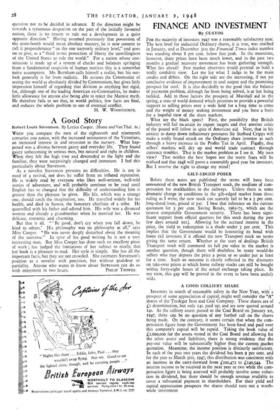FINANCE AND INVESTMENT
-By CUSTOS
FOR the majority of investors 1947 was a reasonably satisfactory year. The best level for industrial Ordinary shares, it is true, was reached in January, and at December 31st the Financial Times index number was standing about 8 per cent. below that peak. In the meantime, however, share prices have been much lower, and in the past two months a gradual recovery movement has been gathering strength. What lies ahead? Few market observers would pretend to hold a really confident view. Let me list what I judge to be the main credits and debits. On the right side are the increasing, if not yet conclusive evidence of improvement in coal output and the promising prospect for steel. It is also decidedly to the good that the balance of payments problem, although far from being solved, is at last being tackled. Add to those factors the prospect of Marshall aid in the spring, a state of world demand which promises to provide a powerful support to selling prices over a wide field for a long time to come and the weight of money seeking investment and you have a basis for a hopeful view of the share markets.
What are the black spots? First, the possibility that British industry will fail tcrattain its export targets and that another crisis of the pound will follow in spite of American aid. Next, that in his anxiety to damp down inflationary pressures Sir Stafford Cripps will make a really brutal attack on the Ordinary share investor as such through a heavy increase in the Profits Tax in April. Finally, that sellers' markets will dry up and world trade contract through currency troubles. That is the market problem as I see it. My own view? That neither the best hopes nor the worst fears will be realised and that 1948 will prove a reasonably good year for investors. But I reserve the right to change my mind!
GILT-EDGED POSER
Before these notes are published the terms will have been announced of the new British Transport stock, the medium of com- pensation for stockholders in the railways. Unless there is some dramatic' change in conditions in the gilt-edged market from those ruling as I write, the new stock can scarcely fail to be a 3 per cent. long-dated issue, priced at par. I base that inference on the current quotation for 3 per cent. Saving Bonds, 1965-75, which are the nearest comparable Government security. There has been signi- ficant support from official quarters for this stock during the past few days around mit Allowing for the accrued interest in the price, the yield to redemption is a shade under 3 per cent. This implies that the Government would be honouring its bond with home rail investors if it offered the new Transport stock on terms giving the same return. Whether at the start of dealings British Transport stock will command its full par value in the market is another question, though there will doubtless be many would-be sellers who may depress the price a point or so under par at least for a time. Such an outcome is clearly reflected in the discounts on take-over prices at which home railway stocks can still be bought within forty-eight hours of the actual exchange taking place. In my view, this gap will be proved in the event to have been unduly wide.
A GOOD COLLIERY SHARE
Investors in search of reasonable safety in the New Year, with' a prospect of some appreciation of capital, might well consider the"A" shares of the Tredegar Iron and Coal Company. These shares are of ,Cr denomination, but only 145. paid up, and are now quoted around Ets. As the colliery assets passed to the Coal Board on January .rst, 1947, there can be no question of any furthei call on the shares being made. On the contrary, it seems certain that when the com- pensation figure from the Government has been fixed and paid over this company's capital will be repaid. Taking the book value of £2,600,000 for the assets vested in the Coal Board and allowing for the other assets and liabilities, there is strong evidence that the pay-out value will be substantially higher than the current iparket quotation. Meantime, the income position is distinctly satisfactory. In each of the past two years the dividend has been 9 per cent. and for the year to March 31st, 1947, this distribution was consistent with an increase in the carry-forward from £101,472 to L14o,544.. The interim income to be received in the next year or two while the com- pensation figure is being assessed will probably involve some reduc- tion in dividend, but there should be enough revenue available to cover a substantial payment to shareholders. For their yield and capital appreciation prospects the shares should turn out a worth- while investment






































 Previous page
Previous page